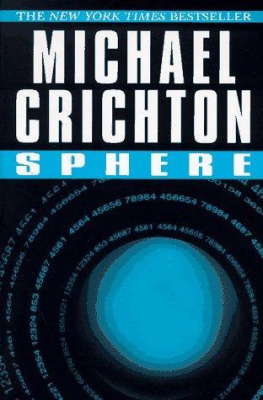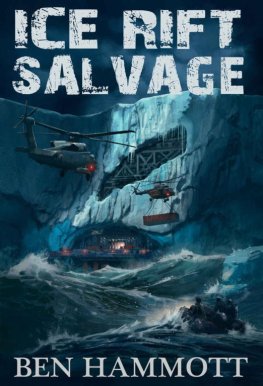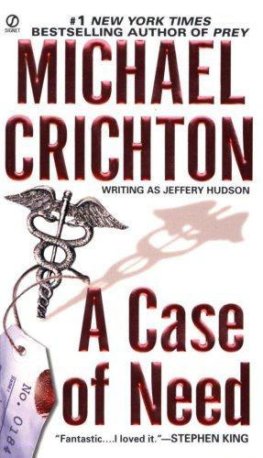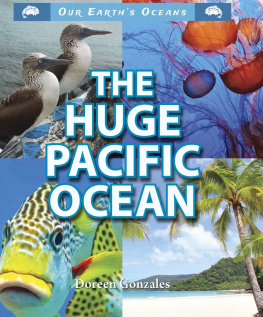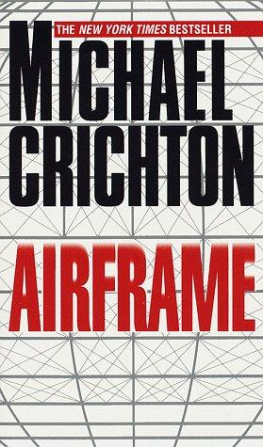Sphere
Sphere
SPHERE
A Novel by
Michael Crichton
BALLANTINE BOOKS NEW YORK
Sale of this book without a front cover may be unauthorized. If this book is coverless, it may have been reported to the publisher as unsold or destroyed and neither the author nor the Publisher may have received payment for it.
Copyright 1987 by Michael Crichton
All rights reserved under International and Pan-American Copyright Conventions. Published in the United States of America by Ballantine Books, a division of Random House, Inc., New York, and simultaneously in Canada by Random House of Canada Limited, Toronto.
Library of Congress Catalog Card Number: 86-46321
http://www.randomhouse.com
ISBN 0-345-35314-5
This edition published by arrangement with Alfred A. Knopf, Inc.
Manufactured in the United States of America
First International Edition: February 1988 First U.S. Edition: August 1988
20 19 18 17 16 15 14 13 12
FOR LYNN NESBIT
When a scientist views things, hes not considering the incredible at all.
LOUIS I. KAHN
You cant fool nature.
RICHARD FEYNMAN
During the preparation of this manuscript, I received help and encouragement from Caroline Conley, Kurt Villadsen, Lisa Plonsker, Valery Pine, Anne-Marie Martin, John Deubert, Lynn Nesbit, and Bob Gottlieb. I am grateful to them all.
CONTENTS
THE SURFACE
THE DEEP
THE MONSTER
THE POWER
THE SURFACE
WEST OF TONGA
For a long time the horizon had been a monotonous flat blue line separating the Pacific Ocean from the sky. The Navy helicopter raced forward, flying low, near the waves. Despite the noise and the thumping vibration of the blades, Norman Johnson fell asleep. He was tired; he had been traveling on various military aircraft for more than fourteen hours. It was not the kind of thing a fifty-three-year-old professor of psychology was used to.
He had no idea how long he slept. When he awoke, he saw that the horizon was still flat; there were white semicircles of coral atolls ahead. He said over the intercom, Whats this?
Islands of Ninihina and Tafahi, the pilot said. Technically part of Tonga, but theyre uninhabited. Good sleep?
Not bad. Norman looked at the islands as they flashed by: a curve of white sand, a few palm trees, then gone. The flat ocean again.
Whered they bring you in from? the pilot asked.
San Diego, Norman said. I left yesterday.
So you came Honolulu-Guam-Pago-here?
Thats right.
Long trip, the pilot said. What kind of work you do, sir?
Im a psychologist, Norman said.
A shrink, huh? The pilot grinned. Why not? Theyve called in just about everything else.
How do you mean?
Weve been ferrying people out of Guam for the last two days. Physicists, biologists, mathematicians, you name it. Everybody being flown to the middle of nowhere in the Pacific Ocean.
[[4]] Whats going on? Norman said.
The pilot glanced at him, eyes unreadable behind dark aviator sunglasses. Theyre not telling us anything, sir. What about you? Whatd they tell you?
They told me, Norman said, that there was an airplane crash.
Uh-huh, the pilot said. You get called on crashes?
I have been, yes.
For a decade, Norman Johnson had been on the list of FAA crash-site teams, experts called on short notice to investigate civilian air disasters. The first time had been at the United Airlines crash in San Diego in 1976; then he had been called to Chicago in 78, and Dallas in 82. Each time the pattern was the samethe hurried telephone call, frantic packing, the absence for a week or more. This time his wife, Ellen, had been annoyed because he was called away on July 1, which meant he would miss their July 4 beach barbecue. Then, too, Tim was coming back from his sophomore year at Chicago, on his way to a summer job in the Cascades. And Amy, now sixteen, was just back from Andover, and Amy and Ellen didnt get along very well if Norman wasnt there to mediate. The Volvo was making noises again. And it was possible Norman might miss his mothers birthday the following week. What crash is it? Ellen had said. I havent heard about any crash. She turned on the radio while he packed. There was no news on the radio of an airline crash.
When the car pulled up in front of his house, Norman had been surprised to see it was a Navy pool sedan, with a uniformed Navy driver.
They never sent a Navy car the other times, Ellen said, following him down the stairs to the front door. Is this a military crash?
I dont know, he said.
When will you be back?
He kissed her. Ill call you, he said. Promise.
But he hadnt called. Everyone had been polite and pleasant, but they had kept him away from telephones. First at Hickam Field in Honolulu, then at the Naval Air Station in Guam, where he had arrived at two in the morning, and had [[5]] spent half an hour in a room that smelled of aviation gasoline, staring dumbly at an issue of the American Journal of Psychology which he had brought with him, before flying on. He arrived at Pago Pago just as dawn was breaking. Norman was hurried onto the big Sea Knight helicopter, which immediately lifted off the cold tarmac and headed west, over palm trees and rusty corrugated rooftops, into the Pacific.
He had been on this helicopter for two hours, sleeping part of the time. Ellen, and Tim and Amy and his mothers birthday, now seemed very far away.
Where exactly are we?
Between Samoa and Fiji in the South Pacific, the pilot said.
Can you show me on the chart?
Im not supposed to do that, sir. Anyway, it wouldnt show much. Right now youre two hundred miles from anywhere, sir.
Norman stared at the flat horizon, still blue and featureless. I can believe it, he thought. He yawned. Dont you get bored looking at that?
To tell you the truth, no, sir, the pilot said. Im real happy to see it flat like this. At least weve got good weather. And it wont hold. Theres a cyclone forming up in the Admiralties, should swing down this way in a few days.
What happens then?
Everybody clears the hell out. Weather can be tough in this part of the world, sir. Im from Florida and I saw some hurricanes when I was a kid, but youve never seen anything like a Pacific cyclone, sir.
Norman nodded. How much longer until we get there?
Any minute now, sir.
After two hours of monotony, the cluster of ships appeared unusually interesting. There were more than a dozen vessels of various kinds, formed roughly into concentric circles. On the outer perimeter, he counted eight gray Navy destroyers. Closer to the center were large ships that had wide-spaced double hulls and looked like floating [[6]] dry-docks; then nondescript boxy ships with flat helicopter decks; and in the center, amid all the gray, two white ships, each with a flat pad and a bulls-eye.
The pilot listed them off: You got your destroyers on the outside, for protection; RVSs further in, thats Remote Vehicle Support, for the robots; then MSS, Mission Support and Supply; and OSRVs in the center.
OSRVs?
Oceanographic Survey and Research Vessels. The pilot pointed to the white ships. John Hawes to port, and William Arthur to starboard. Well put down on the Hawes. The pilot circled the formation of ships. Norman could see launches running back and forth between the ships, leaving small white wakes against the deep blue of the water.
All this for an airplane crash? Norman said.
Hey, the pilot grinned. I never mentioned a crash. Check your seat belt if you would, sir. Were about to land.
BARNES
The red bulls-eye grew larger, and slid beneath them as the helicopter touched down. Norman fumbled with his seat belt buckle as a uniformed Navy man ran up and opened the door.
Dr. Johnson? Norman Johnson?

